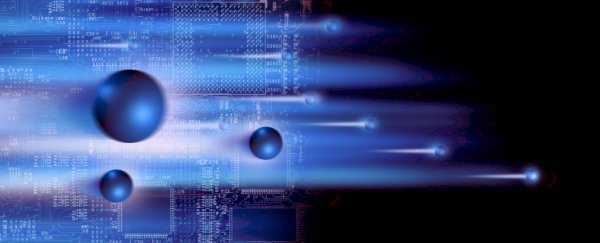It may have once been regarded as that 'freaky kid' of the physics world, but quantum entanglement has literally come a long way from the days when Einstein laughed it off as "spooky action at a distance".
In a new study, scientists have successfully transmitted entangled photons between a satellite and Earth at a distance of over 1,200 kilometres (750 miles). This smashes the previous record for entanglement distribution, which only reached up to 100 kilometres.
"We have demonstrated the distribution of two entangled photons from a satellite to two ground stations that are 1,203 kilometres apart," says Juan Yin, lead author and physicist at the Science and Technology University of China in Shanghai, in the research paper.
"Long-distance entanglement distribution is essential for the testing of quantum physics and quantum networks."
Once scoffed at by Einstein, quantum entanglement is a strange phenomenon that occurs when two or more particles link up and instantaneously affect each other, regardless of how far apart they are.
If for example, we make one particle spin in a clockwise direction, then quantum entanglement predicts that the other particle will spin in an anti-clockwise direction, whether it's 1 centimetre away, or at the other end of the cosmos.
While Einstein wasn't so sure that such weird particle behaviour was actually playing out in the real-life Universe, quantum entanglement has become a key to exploring how information can be transmitted over long distances.
This is already coming in handy for applications in hack-proof banking and supercomputing.
But so far, physicists have only managed to distribute entangled particles over a distance of up to 100 kilometres. The tricky thing about achieving long-distance entanglement is that the particles tend to get lost as they travel along optical fibres, or over open land.
There are a couple of ways physicists can tackle this problem. One way to improve particle distribution is to break the transmission line into smaller sections, and then swap, purify, and store the quantum information along the optical fibre.
This is all well and good, but getting all of these elements to work together seamlessly is still a difficult task when information needs to be stored for long periods and retrieved quickly.
Fortunately, Yin and his team have just demonstrated a better way for achieving global quantum networks using laser beams and satellite technology.
With the help of Micius - the world's first quantum-enabled satellite launched last year - the researchers set out to communicate with three ground stations across China using entangled photons (light particles).
Each of the stations were around 1,200 kilometres apart and between 500 to 2,000 kilometres away from the orbiting satellite.
Using a beam splitter, they split the laser beam from the satellite into two distinct polarised states. One of these split beams was used to send the entangled photons, while the other acted as a photon receiver.
Despite the long round-trip, the photons maintained their entanglement and were successfully received by the ground stations that were over a thousand kilometres apart.
"The result again confirms the nonlocal feature of entanglement and excludes the models of reality that rest on the notions of locality and realism," the team writes in their paper.
"Compared with the previous method of entanglement distribution by direct transmission of the same two-photon source the link efficiency of our satellite-based approach is 12 and 17 orders of magnitude higher."
The main benefit of this approach is that satellites can easily cover two Earth-based locations that are thousands of kilometres apart. As most of the transmission path is in a vacuum, there's almost no loss of particles.
"Even if perfect optical fibres were produced in the future, our satellite-based method would still be four to eight orders of magnitude more efficient," writes the team.
While quantum entanglement will always mess with our minds, these new findings open up a whole new realm of real-world applications, from better communication networks to secure payment systems.
Let's hope it won't be too long before someone smashes this record.
The research has been published in Science.
